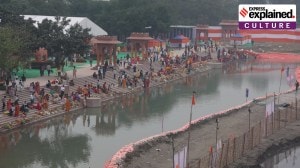No human chains in Mumbai
When Benazir Bhutto died, Mumbaikars held a candle-light vigil.

When Benazir Bhutto died, Mumbaikars held a candle-light vigil. Nandigram saw spirited sloganeering outside the CPM office here in Mumbai. When Medha Patkar was being force-fed in Delhi two years back, celebrities formed a human chain at Marine Drive. Artists protested elegantly outside Jehangir Art Gallery when the VHP vandalised Baroda’s MS University. The shooting down in faraway Kalinganagar of 21 Adivasis merited a protest at Churchgate.
But all through the 10 days that some Mumbaikars were being thrashed and their means of livelihood burnt, and these acts were being telecast repeatedly, the silence of Mumbai’s intellectuals was deafening.
If ever a cause deserved a human chain, this one did. But it seemed Mumbai had no time to show it cared.
“Incidents like these keep happening,” laughed Maharashtra’s super cool chief minister. The last time specific groups were attacked only because they had the wrong name was in a church on Xmas eve in 1998, resulting in instant protests, though the attack was confined to one suburb. December ’92 and January ’93 saw the last citywide outbreak of violence based only on identity. At that time, former Prime Minister V.P. Singh had fasted in protest in the heart of the city, followed by Congress MP Sunil Dutt outside the seat of government. On the Republic Day that followed the riots, a human chain had linked South to North Mumbai.
This time neither Sunil Dutt’s MP daughter, nor any Marathi intellectual thought fit to speak out. No one from Mumbai’s multilingual theatre world challenged Raj Thackeray’s father-in-law Mohan Wagh, an award-winning theatre personality, when he praised the man who had unleashed the violence as a “nice boy, the real leader of the Marathi manoos”.
It wasn’t fear, surely, that deterred protests. In the past, not even Bal Thackeray’s brute force has silenced Mumbai’s intellectuals.
It can be said that from the time a Mumbaikar wakes up, till the time she reaches home from work, she depends on the back-breaking work done by North Indians for little money and less security. Yet, the sight of these very doodhwallas and istriwallas pushing their women into packed compartments of north-bound trains, didn’t provoke Mumbai’s activists into demonstrating against the police for their failure to protect the ordinary citizen. Dadar’s halls have been booked for meetings on smaller causes!
Pune was not where Raj Thackeray declared that ‘bhaiyyas’ must get the message that they were not welcome. Yet, sensing their fellow Puneites’ insecurity, veteran social activists led by the 75-plus Baba Adhav and Mohan Dharia, held rallies to say that ‘bhaiyyas’ were indeed welcome.
Raj Thackeray’s venom didn’t affect the friendships that cut across language in this city — this was obvious in the local trains, where large groups travel together, morning and evening. But the violence he instigated demeaned every Mumbaikar. Mumbai’s intellectuals should have apologised to their fellow citizens for the humiliation the latter were subject to. Their silence is a sign of a failed city.



- 01
- 02
- 03
- 04
- 05




























